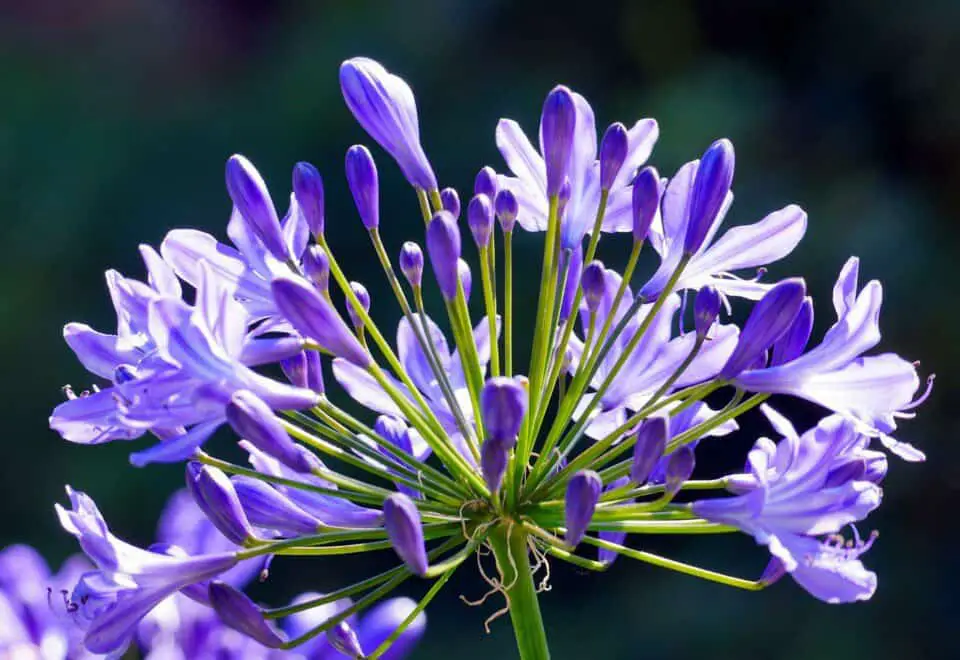Some links in the post are affiliate links and I get a commission from purchases made through some links found in the post.
The bright coloured Agapanthus, more commonly known as Lily of the Nile, require special care in the winter season. By following just a few simple steps, these plants can be protected from this cold season.
For you to be able to care for your agapanthus in the winter season, it’s important to determine whether the tubers are evergreen or deciduous.
This can be done by checking if your agapanthus keeps its leaves after summer. If the answer is yes, then your agapanthus is evergreen. But if the leaves die back naturally, then it is deciduous.
These are a bit hardier as they come from the cooler regions of Africa. According to trials conducted in the UK, the deciduous can survive in the outdoors with little protection.
Special Agapanthus winter care is needed when the plant is evergreen, unknown or grown in northern regions with hard freezes.
The U.S. Department of Agriculture Zones recommends 6 to 11 growing zones are suitable for growing agapanthus.
The evergreen varieties are less cold hardy and the cultivation zones of 8 and above will be better suited for them. Whereas the deciduous varieties are more cold hardy and can sustain even in cultivation zone 6.
When the winter arrives steps should be taken to dig up the tubers, brush off the soil and cut back the foliage before the cold temperatures arrive or you could risk losing your plant.
Allow the tubers to dry out for a few days in a warm and dry location followed by storing them wrapped up in newspaper in a cool and dark location.
The optimum temperature for storing the agapanthus in the winter is 40 to 50 degrees Fahrenheit (4 to 10 C.). You can then replant tubers in the following spring.
How To Care for An Agapanthus in Winter
 Agapanthuses are easy to grow, pest and disease free. They are brightly coloured flowers on stiff, upright stalks. For this beautiful plant to thrive, it needs full sun and 6 to 8 hours of sunlight.
Agapanthuses are easy to grow, pest and disease free. They are brightly coloured flowers on stiff, upright stalks. For this beautiful plant to thrive, it needs full sun and 6 to 8 hours of sunlight.
It may do better in partial shade in the hot climate areas. The soil for the agapanthus should be fertile, moist, and well-drained. There is no preference for the pH of the soil.
Most gardeners agree that the agapanthus cannot withstand cold. However, in some cases they can survive surprisingly well even in cooler climates.
Agapanthus is moderately frost tolerant. By moderate, I mean they can withstand light, short frosts that do not sustainably freeze the ground hard.
The top of the plant will die back in a light frost, but the thick, fleshy roots will retain vitality and re-sprout in spring.
With the conditions required for the agapanthus to thrive, it is usually not possible for us to provide them with these during the winter season. This is especially true for Zones 6 and below.
The shorter days do not provide the plant with the required sunlight hours and freezing temperatures make it difficult to keep the plant well drained and moist.
You may also like: Why is my agapanthus not flowering & how to fix it
How to Care for an Evergreen Agapanthus in the Winter?
If the type of your agapanthus is Evergreen, then you need to first find out which cultivation Zone you are located in. Depending upon that, you can decide whether you need to keep your agapanthus indoors or outdoors during winter.
For indoor winter care of your agapanthus, it would be ideal to plant them inside containers. In this way when the first frost arrives, you can bring them indoors and keep them protected from the decreasing temperatures.
The outdoor winter care for agapanthus will be different from the indoor care. It is more convenient and requires fewer steps.
How to Care for an Evergreen Agapanthus in the Winter in the UK?
Most of the United Kingdom is in USDA zone 9, although climates as chilly as zone 8 or as mild as zone 10 aren’t uncommon. Generally, the UK is marked primarily by cool (but not frigid) winters and warm (but not scorching) summers.
These zones are better suited for planting your agapanthus in the ground, which means outdoors, instead of a pot. As you will not need to change their location even when winter arrives.
If you live in an area where temperatures don’t drop below 55°F, there’s not much you need to do during the winter except water your plant less often, since it isn’t actively growing – once every week or week and a half should suffice.
Just don’t allow the soil to get bone dry two inches down and keep an eye on the weather to make sure you’re not caught off guard by a surprise cold snap.
If temperatures are predicted to remain below 55°F, you can add a two-to three-inch layer of mulch to the root area to help keep the plant insulated.
You can also pop a portable mini greenhouse over top of the plants to trap some heat and protect them from temperatures below 55°F.
How to Care for an Evergreen Agapanthus in the Winter in the USA?
 The USA is divided into 13 different agricultural zones. The winter care needed to be taken will depend on your agapanthus type and the zone you are in.
The USA is divided into 13 different agricultural zones. The winter care needed to be taken will depend on your agapanthus type and the zone you are in.
If you are in Zone 7 or above, then outdoor care like the one for the UK would be perfect.
However, if you are in Zone 6 or below then it would be ideal to plant your agapanthus in a pot. This will allow you to relocate the plant when temperatures drop.
When you bring your agapanthus plant indoors, make sure to place it in a dry, cool, and bright location with temperatures in 55-60°F range.
Any indoor area could work as long it is unheated and well lit. You can experiment using ordinary fluorescent bulbs, keeping them about one to two inches away from the plants.
Running them for about 12 to 14 hours each day would be ideal for your plants. Or you could place them near a window where they can get plenty of sunlight while they are indoors.
Evergreen Agapanthus should be provided with a cup of water each month while it is indoors in the winter as it helps to replenish the water lost due to evaporation.
This is important if you live in a dry region, or your plant is indoors. You should only water the agapanthus when the top two inches are dry. Alongside, suspend fertilising them until the onset of spring.
If you have not planted your evergreen agapanthus in a pot, and feel the need to transplant it, then you may want to consider leaving your evergreen agapanthus in a pot for at least a few years.
As disturbing the roots more than once every three to four years can stress the plant and prevent it from blooming reliably.
You may also like: Why are your agapanthus leaves turning yellow & fixes
How to Care for the Deciduous Agapanthus in the Winter in the UK
Deciduous varieties do best if temperatures remain consistently between 40 and 50°F. They should be allowed to rest during the winter season.
Allow their leaves to die back naturally. In doing so, energy for next year will be stored in the rhizomes. When all the leaves turn brown and have died back, you can cut the stems back to four inches above the ground.
Since the plant has no leaves during the winter, there are no light requirements to follow until foliage begins to grow back again in the spring – at which point, it once again needs full sun to thrive.
The deciduous plant needs to be watered every two to three weeks during winter. It is important to make sure that the soil does not go bone dry for more than four to five inches down.
This winter care will sustain deciduous agapanthus plants if they are growing in the ground in Zones 8 and 9.
On the other hand, if you are a gardener in Zones 6 and 7 you will also need to apply a two-to three-inch layer of organic mulch before the arrival of the first frost along with the steps mentioned above.
Be observant of the weather in your area as well as the expected date of the first frost. According to that, make sure to apply mulch if the temperatures drop below 40°F.
How to Care for the Deciduous Agapanthus in the Winter in the USA?
If your agriculture zone in the USA is above 7 then following the same steps as those discussed for the UK will be sufficient for you.
But if you live in Zone 5 or Zone 6 then the care mentioned above will not be enough. It would be best if you transplant your agapanthus upon the arrival of the winter season.
You can transplant it into a container and move it to an insulated garage or basement. But transplanting the deciduous agapanthus requires a few prerequisites.
Firstly, select a planter that’s 12 inches deep and 12 inches wide, with drainage holes. Add fresh, well-draining potting mix to the container, filling it about halfway.
Mark out a perimeter that is at least six inches away from the foliage of your plant. You can do this with the help of a trowel. This step needs to be performed for the safe removal of your agapanthus from its place in your garden to the container.
 Now, dig down around the entire perimeter that you had marked out. Go about eight to 12 inches deep before slowly tugging the plant out.
Now, dig down around the entire perimeter that you had marked out. Go about eight to 12 inches deep before slowly tugging the plant out.
Set it in its new container and add more potting mix, leaving an inch between the top of the soil and the lip of the pot. Water thoroughly, making sure water runs out the bottom of the pot.
Move the container to your insulated garage or basement. The temperature of the indoor location where you move your container should be between 40 and 50°F.
It is not recommended to bring deciduous agapanthus plants indoors. However, moving these into a warmer part of your home can prevent the plant from going dormant, which can affect its health and ability to bloom come springtime.
As the days get longer and warmer in the spring season, which is usually about two weeks after your area’s average last frost date, you can bring the plant back outside and either leave it in its container or move it back into its original planting area.
Keep in mind that transplanting your agapanthus more than once every three to four years can affect its ability to bloom, so you may want to leave it in a container indefinitely. This will make winter care easy every year!
You may also like: 5 great planting combinations with your agapanthus
Final Thoughts
Remember, that once the season starts to change, removing the mulch that you had applied during the winter should be removed from the plants. This is necessary, otherwise your plant will struggle to regrow.
Any agapanthus containers that you had placed indoors during the winter season can be brought outside upon the onset of the spring season. As agapanthus need the sunlight and moist environment to grow.


